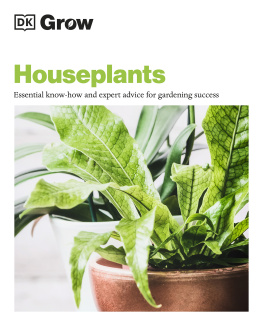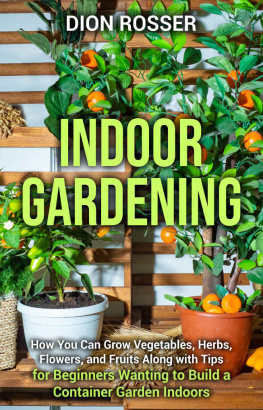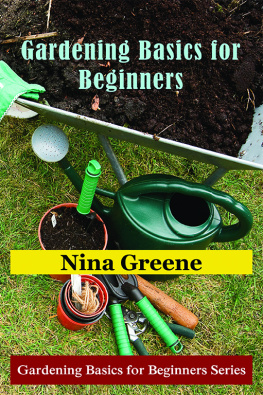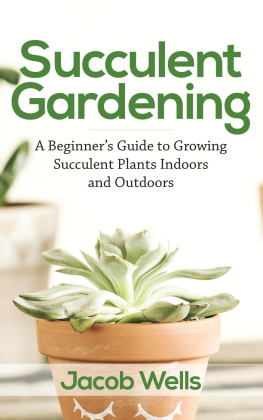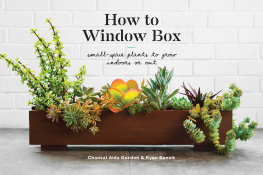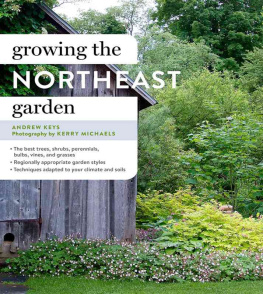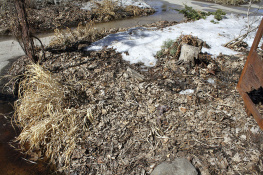GARDENING UNDER LIGHTS
The Complete Guide for Indoor Growers
LESLIE F. HALLECK
TIMBER PRESS PORTLAND, OREGON
CONTENTS
PREFACE
Being obsessed with plants by the time I was 18 years old didnt exactly make me popular at parties. As my original plant friend, Carolyn, will tell you, the two of us could clear a room quickly once the surrounding college partygoers heard us talking about our cactus or cross-pollination. We just couldnt help ourselves, and were still at it today. However, my status at The University of North Texas as one of only two students (at the time) concentrating in botany, my curious reputation as a gardener, and my college job as a garden-center employee made my phone ring a bit more frequently than my social status warranted. If only I had known I could have made some cash telling anonymous callers how to stop killing their closet so-called tomato plants. But I was never interested in what was actually growing in their closets. I was content to be knee-deep in my outdoor ornamental and vegetable garden, not to mention obsessed with an increasingly large collection of houseplants. But Im glad those closet gardeners called, because it was the start of my horticultural consulting careerand, as it turns out, this book.
I spent my first two years of university life at UNT as an art major before I switched to biology and botany. As such, aesthetic considerations are infused into all my pursuits, even the scientific ones. The fusion of art and horticulture is natural. Growing plants and food indoors doesnt have to be utilitarian; it can be a beautiful practice that blends into our living space and lifestyles. Within this book youll find examples and inspiration for your own attractive plant lighting.
As a graduate student at Michigan State University, my research focused on greenhouse production and flowering of perennial plants. Therefore, you will also encounter some science and math, which may seem a bit confounding at first. If you dont need this information, feel free to skip it. If you have intensive indoor gardening goals, however, the more in-depth how-tos on measuring and calculating your indoor lighting needs will likely form the basis of your long-term success.
As it turns out, writing this book feels like Im coming full circle to bring the closet garden to light. I hope this book encourages your interest in, and creates new possibilities for, growing plants where you once thought you could not. Perhaps youre on a mission to grow more of your own food or medicinals, even if all you have is a kitchen counter, a guest room corner, or a small closet. You may want to extend your vegetable-gardening season by getting a jump-start on propagation or growing indoors off-season. Having control over your own food source is a powerful feeling. Its good to eat fresh, hyperlocal, and clean. Or maybe, like me all those years ago, you have caught the plant-collecting bug and there just arent enough windowsills left in your home to feed your growing plant family. In any case, youve come to the right place.

Some plants, such as haworthias, can survive in a windowsill.
INTRODUCTION
My window is bright enough, right? New indoor growers ask this hopeful question all too frequently. While many books and websites insist that you need only a bright window to get your tomato seeds going or your orchids reblooming, this approach can result in a lot of disappointment.
Ambient light levels inside your home are significantly lower in intensity and ultimately different in spectrum than natural outdoor light, especially during the winter months. Even a seemingly bright window may not provide enough light, or the right kind, for young seedlings or fruit-producing plants. Have you ever started seeds indoors in a sunny window, only to watch the tiny seedlings lean so far that they topple over? Perhaps youve tried some beautiful succulents and watched them do the same. Your plants are starving for, and stretching toward, the light.
There are plenty of low-light tropicals and blooming plants that you can grow successfully indoors with good ambient light, and you can maintain certain light-loving succulents for a while in a windowsill. But even a bright windowsill is typically not the right location for plants you intend to harvest for food. The same goes for heavy-blooming plants. Reproduction is an energy-intensive process. Producing flowers, fruit, and seed requires a lot of juice. Plants need enough light, and the right kind of light, to get the job done.
You may have learned that in your outdoor garden, plants that produce large fruit, such as tomatoes, require roughly double the duration and intensity of direct sunlight as plants that produce mostly foliage, such as leafy greens and lettuce. A plants heritagethat is, the geographical area where it naturally evolveddictates its requirements for specific light intensity, duration, and spectrum to reproduce successfully. If you are going to invest time, effort, and money in indoor growing, quality supplemental lighting should be your number-one priority.
Before we draw up your shopping list of types of lamps and gear you should be using indoors, or determining how many lamps you will need for different types of plants, we must understand how plants use light; how to distinguish light quality, quantity, and duration; and how to measure each. Artificial lighting is complex, and there is a lot of misinformation in the marketplace, which can ultimately lead to wasted resources. To make good grow-lighting choices and produce better yields, it is necessary to grasp some basic botany and light science.
If you already garden outside, growing plants indoors under lights is a great way to supplement your efforts and extend your seasons and yields. If gardening indoors is your only option, grow lighting can transform your living and eating experiences and bring some much-needed nature into your home.

Many plants will need extra light indoors.
LIGHT

WHY PLANTS NEED LIGHT
Understanding how plants use light is crucial to learning how to grow them successfully, especially indoors. A bit of Botany 101 is a good starting place for all plant enthusiasts.
PHOTOSYNTHESIS
Photosynthesis is a reaction to a transfer of energy. Think of a plants leaves and green stems as light-energy collectors; natures very own solar panels. Plant appendages (and several types of microorganisms) use photosynthesis to convert radiant light energy into chemical energy. Light hits the surface of a leaf or a green stem, and specific cells convert the light energy into sugars. These sugars move around the plant, driving various biological functions. A major by-product of photosynthesis is oxygen; hence, we breathe.
When growing plants indoors, your goal should be stimulating and enabling successful photosynthesis. The amount and type of light you provide your plants will ultimately determine their success or failure. Depending on where you live and the time of year, the amount of sunlight penetrating your living room window or filling up your glass greenhouse likely wont be enough to grow many types of plants in an enclosed environment.



